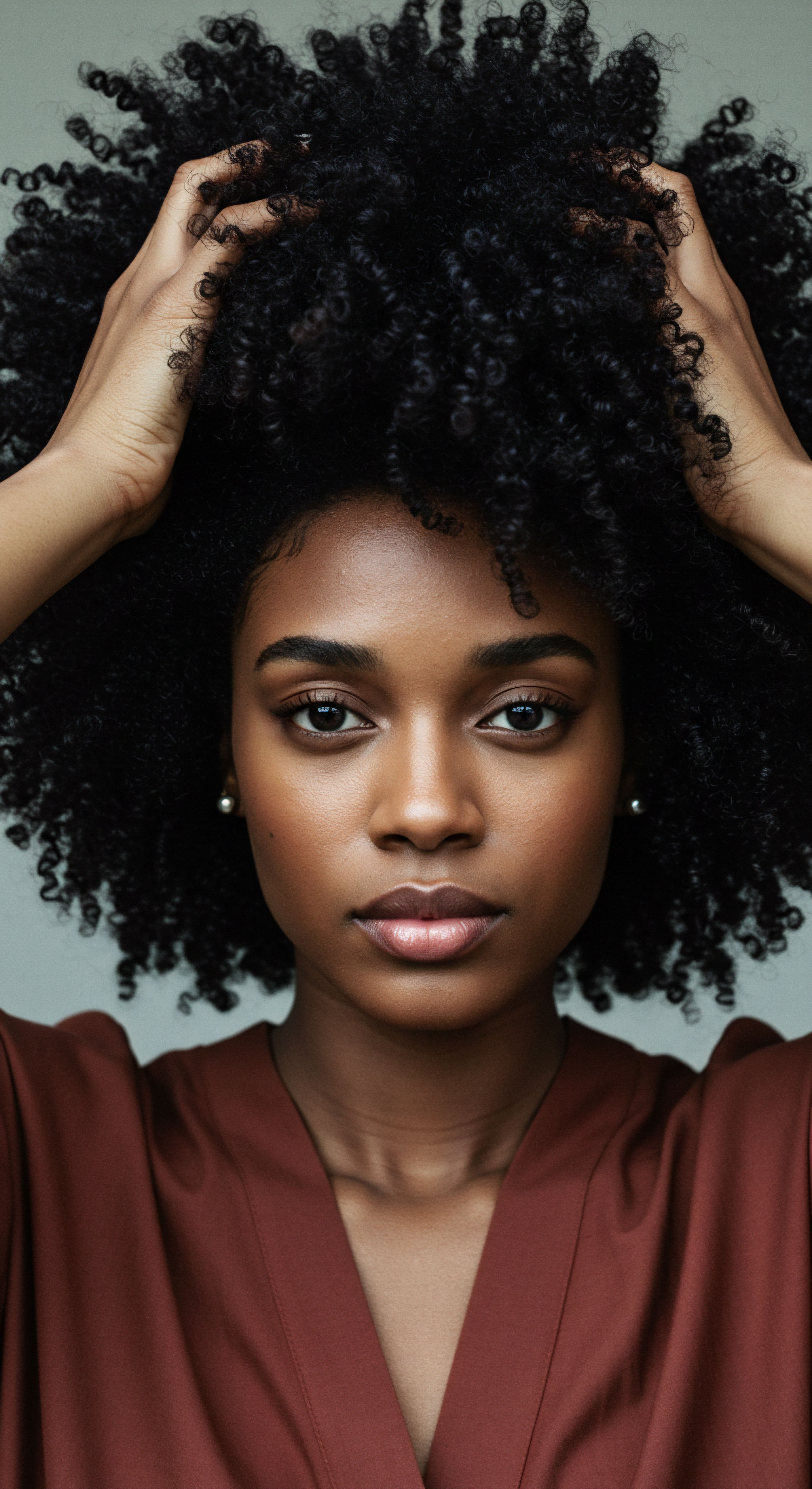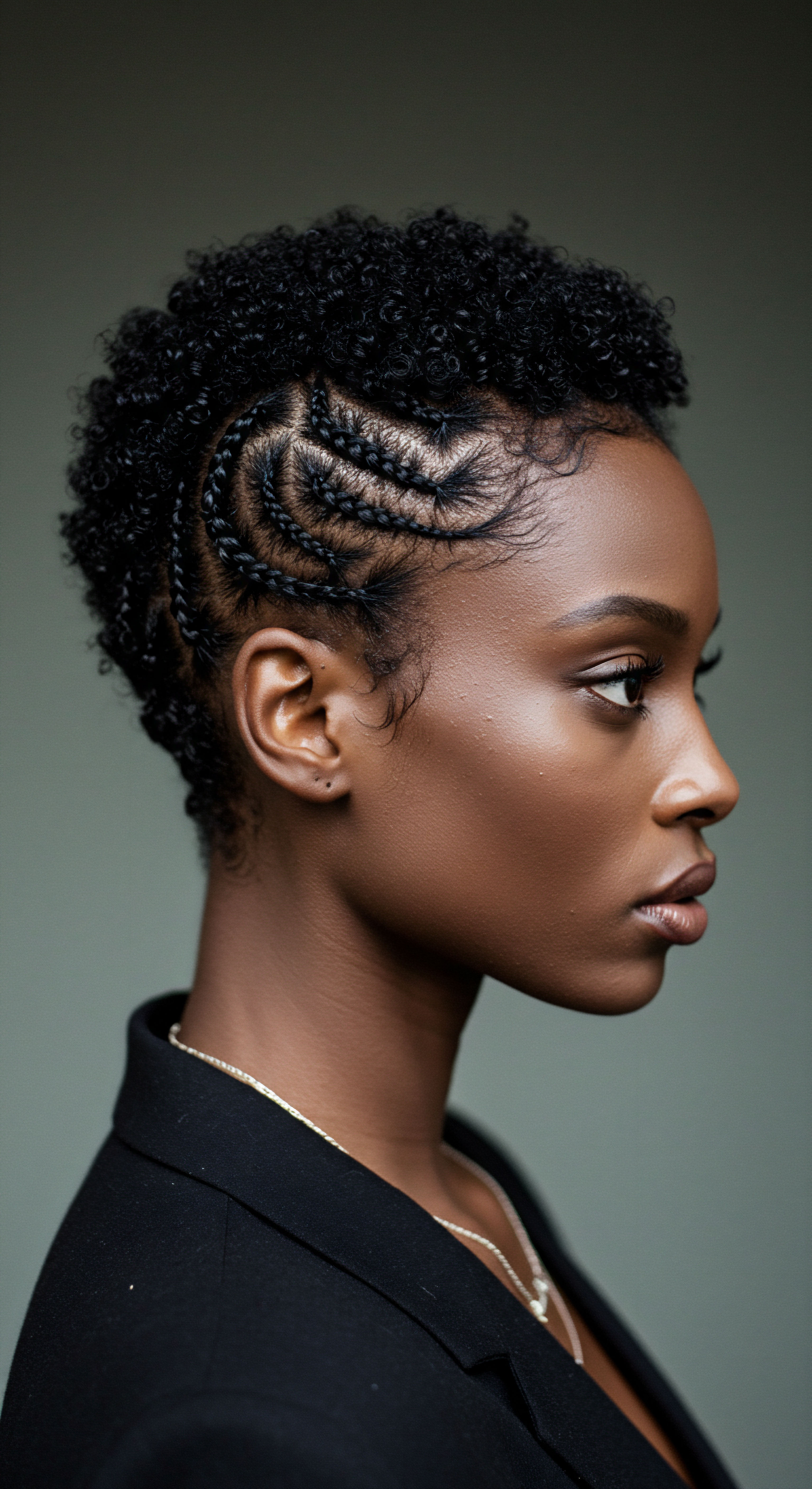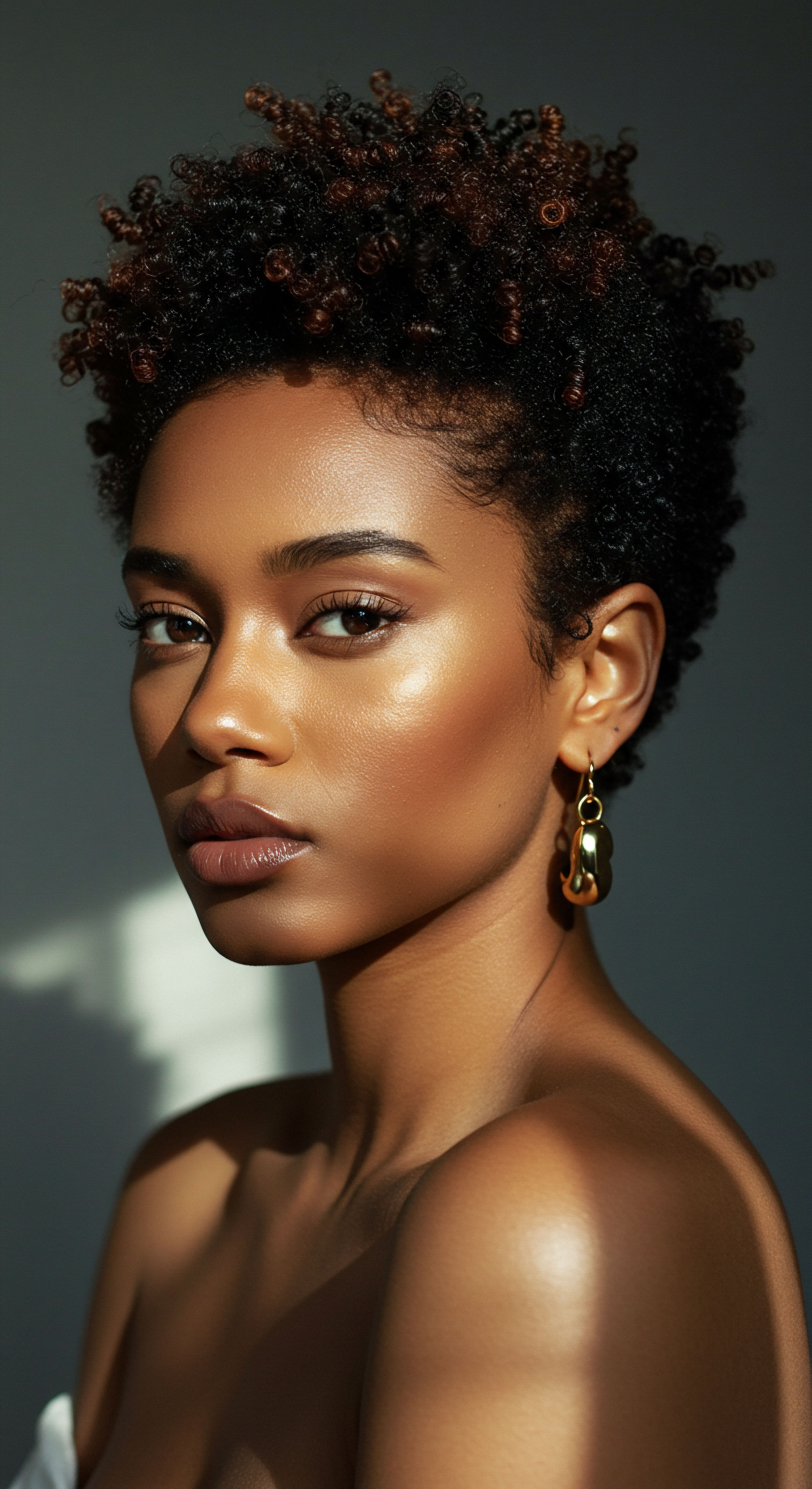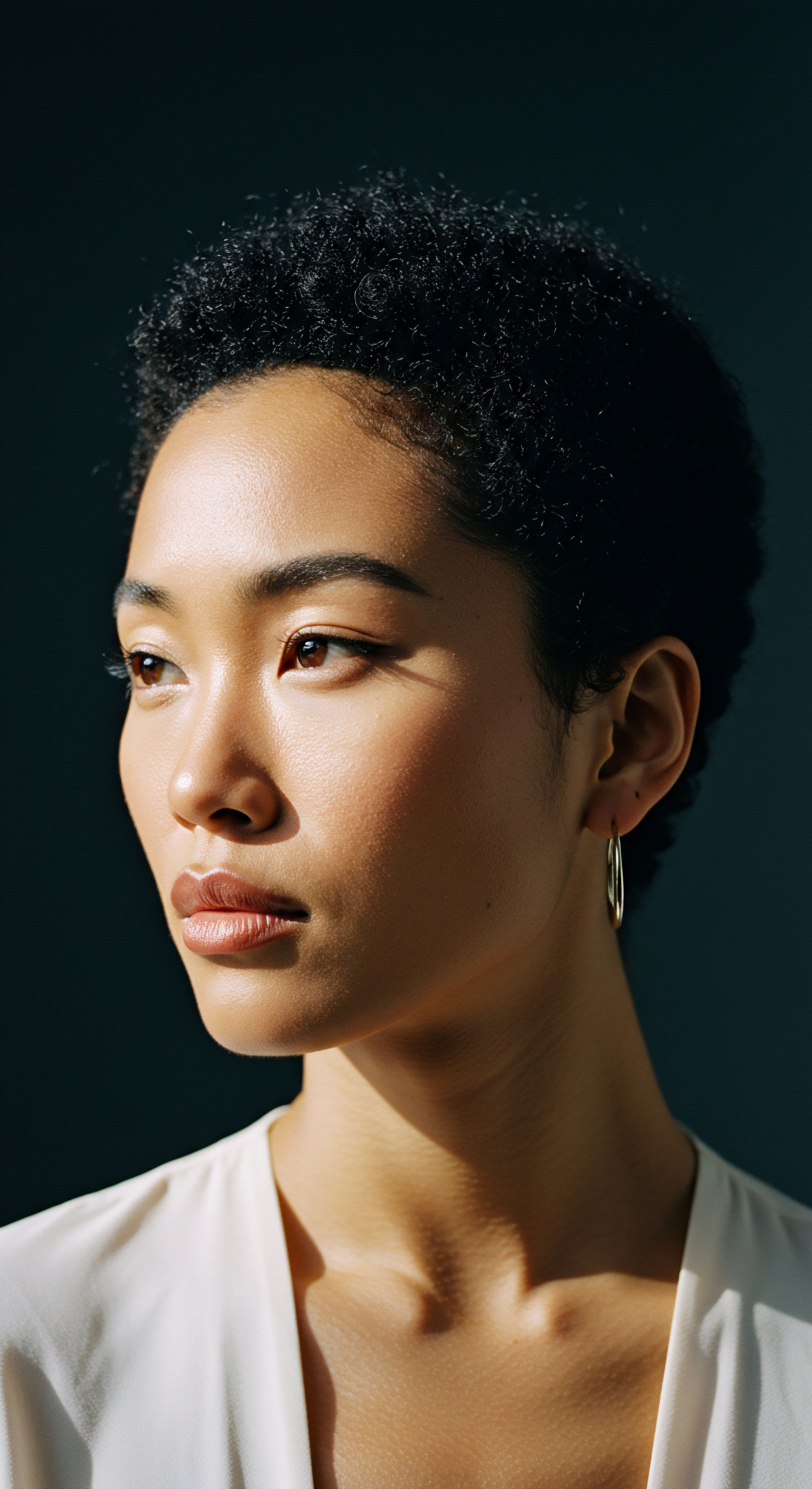The initial search provides several relevant studies, particularly on the impact of hijab wearing on scalp microbiome, and general information about scalp folliculitis and yeast infections related to occlusion and moisture. The study “Scalp microbiome of healthy women wearing hijab compared to those not wearing hijab ❉ a cross-sectional study” seems particularly useful for the unique data point. It states ❉ “Women wearing hijab were found to have more S. capitis and M.
restricta on their scalps while women not wearing hijab were found to have more S. cohnii and M. globosa on their scalps. These findings indicated that women wearing hijab are more prone to seborrheic dermatitis compared to women not wearing hijab while women not wearing hijab are more prone to bacterial skin infections.” This is a strong, specific data point that can be incorporated.
I will proceed with crafting the content, carefully adhering to all the specified constraints, especially the forbidden words list and the unique Roothea voice. I will pay close attention to sentence structure variety and sophisticated language. I will aim for the higher end of the word count to ensure depth. I will also make sure to add the required HTML elements, summaries, lists, and tables.
One specific example I can use from the search results is the study on hijab wearers. It offers a concrete data point about specific microbial shifts (S. capitis, M. restricta vs.
S. cohnii, M. globosa) and their potential link to seborrheic dermatitis or bacterial skin infections. This is unique and backed by research. I will now begin writing the content, focusing on integrating these findings naturally within the Roothea voice.

Roots
The quiet hum of life on our scalps often goes unnoticed, a vibrant, unseen world beneath the surface of our hair. It is a delicate balance, a complex ecosystem of microorganisms that dwell in harmony, or sometimes, in subtle discord. This hidden landscape, known as the scalp microbiome, plays a profound role in the vitality of our hair and the comfort of our skin. When we consider the simple act of covering our heads, a natural question arises ❉ can this age-old practice, so rich in cultural meaning and personal comfort, shift the delicate microbial balance of our scalp?
For generations, head coverings have served myriad purposes—protection from the elements, expressions of identity, or markers of spiritual observance. From the flowing scarves of diverse traditions to the snug caps worn for warmth or sport, these coverings create a microclimate against the scalp. This enclosed environment, distinct from the open air, can alter the conditions where our microscopic residents reside. Understanding these foundational elements of scalp biology is the first step in appreciating the potential interplay between our chosen adornments and the invisible life that thrives beneath.

The Scalp’s Living Surface
Our scalp is not merely a foundation for hair; it is a dynamic biological surface, a habitat for a diverse array of bacteria, fungi, and yeasts. These tiny inhabitants, collectively termed the scalp microbiota, coexist in a finely tuned relationship with our skin, contributing to its overall well-being. A healthy scalp typically exhibits a particular community structure, with certain species present in balanced proportions.
This microbial community influences various aspects of scalp health, from immune responses to the maintenance of the skin barrier. When this equilibrium is disturbed, a condition sometimes referred to as dysbiosis, it can pave the way for discomfort or various scalp conditions.
The environment of the scalp is unique, characterized by its abundance of hair follicles and sebaceous glands, which produce sebum. Sebum, a natural oil, serves as a nutrient source for some of these microorganisms. The pH level of the scalp, its temperature, and moisture levels also play a significant role in determining which microbial species flourish.
Hair density, too, shapes the microenvironmental conditions, affecting moisture retention and the overall diversity of microbial life. These internal factors, combined with external influences, constantly shape the composition of our scalp’s living surface.

Microbial Residents and Their Roles
Among the most common residents of the scalp are bacteria from the genera Cutibacterium (formerly Propionibacterium) and Staphylococcus, alongside fungi from the Malassezia genus. Cutibacterium acnes, for instance, is often associated with healthy scalp conditions. Malassezia yeasts, particularly M. Globosa and M.
restricta, are natural inhabitants, but their overgrowth is frequently linked to conditions like dandruff and seborrheic dermatitis. The delicate balance between these groups is critical for preventing irritation, flaking, and other scalp concerns.
The scalp’s invisible microbial community, a complex interplay of bacteria and fungi, underpins its overall well-being.
Consider the intricate dance of these organisms ❉ some bacteria might produce substances that inhibit fungal overgrowth, while certain fungi might influence the skin’s pH, thereby affecting bacterial populations. This constant interaction highlights why a slight shift in environmental conditions, such as those created by a head covering, could have ripple effects across the entire microbial landscape. Understanding these fundamental relationships helps us appreciate the complexity of scalp health beyond what is visible to the eye.

What Environmental Shifts do Head Coverings Create?
Head coverings, by their very nature, introduce changes to the immediate environment of the scalp. They can influence temperature, humidity, and airflow, thereby creating a distinct microclimate.
- Temperature ❉ A covering can trap heat against the scalp, leading to a slight increase in temperature.
- Humidity ❉ Sweat and natural moisture from the scalp and hair can become trapped, raising the humidity levels.
- Airflow ❉ The covering reduces air circulation, limiting the evaporation of moisture.
These alterations in the microenvironment can favor the proliferation of certain microbial species that thrive in warmer, more humid, and less aerated conditions. For instance, some yeasts, like Malassezia, are known to flourish in hot and humid climates. The prolonged occlusion can also affect the skin’s barrier function, potentially leading to increased permeability. These initial shifts in environmental conditions lay the groundwork for potential changes in the microbial populations residing on the scalp.

Ritual
Our daily rhythms, the gentle rituals we perform for our hair, shape more than just its outward appearance; they profoundly influence the very environment of our scalp. From the mindful selection of a bonnet before sleep to the precise placement of a scarf, these practices are woven into our lives, offering comfort, style, and protection. As we consider the impact of head coverings on the scalp’s microbial residents, we turn to the practical wisdom found in these routines. How do these common acts, repeated day after day, interact with the unseen world of bacteria and fungi, and what understanding can guide us toward serene scalp health?
The choice of material, the duration of wear, and the underlying hair care regimen all contribute to the story unfolding on our scalp. These elements, often overlooked in their individual simplicity, combine to create a cumulative effect. It is within these daily customs that we find opportunities to support the scalp’s natural balance, even when it is covered for extended periods.

The Microclimate Underneath
When a head covering is worn, especially for extended durations, it creates an altered microenvironment. This enclosed space can become warmer and more humid due to trapped body heat and perspiration. Microorganisms, like all living things, respond to their surroundings.
Certain bacteria and fungi prefer these moist, warm conditions. An elevation in humidity, coupled with reduced airflow, can create an ideal setting for the growth of species such as Malassezia yeasts, which are lipophilic, meaning they thrive on the oils present on the scalp.
This altered microclimate does not inherently lead to problems, but it does shift the conditions. The balance of the scalp’s bacterial population is fundamentally connected to limiting fungal growth. If conditions consistently favor fungal growth, it can upset the delicate equilibrium. The scalp’s natural pH, typically slightly acidic, can also be influenced by increased moisture and sweat, potentially favoring the growth of certain microbes.

Duration of Wear and Material Matters
The length of time a head covering is worn plays a role in the extent of microenvironmental change. Short periods may have minimal impact, while prolonged wear, such as for many hours daily, can sustain the conditions that promote shifts in microbial populations. The material of the head covering is also a significant consideration. Fabrics that are less breathable, like certain synthetic materials, may trap heat and moisture more effectively than natural, breathable options such as cotton or silk.
For example, a study conducted in Indonesia, a tropical country where many women wear hijabs, examined the scalp microbiome of healthy women who wore hijabs compared to those who did not. The research, which recruited women wearing hijabs for a minimum of eight hours a day for at least five years, found distinct differences in their scalp microbial communities. Specifically, women wearing hijabs had a higher prevalence of Staphylococcus Capitis and Malassezia Restricta, while those not wearing hijabs showed more Staphylococcus Cohnii and Malassezia Globosa.
These findings suggest that hijab wearers might be more susceptible to seborrheic dermatitis, whereas non-hijab wearers could face a greater inclination toward bacterial skin infections. This real-world data point underscores how prolonged occlusion and environmental factors, influenced by cultural practices, can indeed correlate with shifts in scalp microbial profiles.
Daily practices, from head covering material to duration, subtly reshape the scalp’s unseen microbial landscape.
This research highlights that the interaction is not simply about wearing a covering, but about the specific microbial responses to the altered environment. It prompts a deeper look into how daily habits can gently guide the microscopic residents of our scalp.
| Material Type Silk |
| Breathability High |
| Moisture Retention Low |
| Potential Scalp Environment More balanced, less moisture trap |
| Material Type Satin |
| Breathability Moderate |
| Moisture Retention Low |
| Potential Scalp Environment Similar to silk, good for hair |
| Material Type Cotton |
| Breathability Good |
| Moisture Retention Moderate |
| Potential Scalp Environment Absorbent, can hold some moisture |
| Material Type Synthetics (e.g. Polyester) |
| Breathability Low to Moderate |
| Moisture Retention High |
| Potential Scalp Environment Increased heat and humidity |
| Material Type Selecting breathable materials can aid scalp health when wearing coverings. |

Care Routines and Scalp Harmony
The impact of head coverings is also deeply connected to individual hair care routines. Infrequent washing, for example, can allow for the buildup of sebum and dead skin cells, which provides additional sustenance for microbes and can exacerbate imbalances, particularly under occlusive conditions. Conversely, overly harsh cleansing might strip beneficial microbes and natural oils, leaving the scalp vulnerable. The frequency of washing and the types of products used are thus important considerations.
Maintaining a clean and dry scalp before covering is a simple yet powerful step. Allowing hair to fully air dry before donning a covering can prevent the creation of an excessively damp environment, which is particularly conducive to fungal growth. Regular, gentle cleansing helps to manage sebum levels and remove accumulated debris, supporting a balanced microbial community.

How Can Daily Hair Care Routines Support Scalp Health When Wearing Coverings?
Supporting scalp health when wearing coverings involves a thoughtful approach to daily hair care. It begins with selecting appropriate cleansing products that effectively remove buildup without stripping the scalp’s natural protective layers. Shampoos with gentle surfactants and ingredients that support the microbiome, rather than disrupt it, can make a considerable difference.
- Cleansing Frequency ❉ Adjust washing frequency based on individual scalp oiliness and activity levels.
- Drying Thoroughly ❉ Ensure hair and scalp are completely dry before covering to prevent moisture buildup.
- Product Choices ❉ Favor lightweight, breathable products that do not contribute to follicle blockage.
The aim is to create an environment that discourages the overgrowth of opportunistic microbes while still allowing the scalp to breathe as much as possible within the constraints of wearing a covering. This mindful approach to daily rituals can significantly contribute to maintaining microbial balance and overall scalp well-being.

Relay
Beyond the visible surface, beneath the cultural layers of adornment and tradition, lies a subtle interplay between our practices and the biological rhythms of our scalp. The inquiry into how head coverings affect scalp microbial balance leads us into a deeper realm, where scientific observation meets the rich tapestry of human experience. This is a space where the unseen becomes visible, where the delicate equilibrium of microorganisms on our scalp reflects the choices we make and the environments we inhabit. We seek not simple answers, but a comprehensive understanding that honors both scientific rigor and lived realities.
The scalp microbiome is a dynamic ecosystem, constantly adapting to internal signals and external pressures. When we introduce a consistent external factor like a head covering, we are, in essence, conducting a long-term environmental experiment on this microscopic world. The outcomes of this experiment are not always straightforward, varying greatly depending on individual physiology, climate, and the specifics of the covering itself.

The Complexities of Occlusion
Occlusion, the act of covering or enclosing a surface, inherently alters the skin’s microenvironment. On the scalp, this can lead to increased temperature, humidity, and a reduction in air circulation. These conditions, while seemingly minor, can significantly influence microbial populations.
For instance, higher humidity can support the growth of certain fungal species, particularly those from the Malassezia genus, which are frequently associated with dandruff and seborrheic dermatitis. The sustained warmth and moisture can also affect the skin’s barrier function, potentially making it more permeable or susceptible to irritation.
A significant aspect of this altered environment is the potential for shifts in the balance between bacterial and fungal communities. The human scalp naturally hosts a diverse range of microorganisms, with a healthy scalp typically characterized by a specific composition. When this balance is disturbed, it can lead to conditions such as folliculitis, an inflammation of the hair follicles often caused by bacterial or fungal overgrowth.

Do Specific Microbes Flourish Under Head Coverings?
Research has begun to illuminate which specific microbial groups may respond to the conditions created by head coverings. A cross-sectional study comparing healthy women who consistently wore hijabs to those who did not, conducted in Indonesia, revealed interesting microbial distinctions. The study observed that the scalp microbiomes of hijab-wearing women exhibited a higher prevalence of Staphylococcus Capitis and Malassezia Restricta. In contrast, women who did not wear hijabs showed a greater abundance of Staphylococcus Cohnii and Malassezia Globosa.
This particular finding holds considerable weight. An increased abundance of M. Restricta, accompanied by a decrease in M. Globosa, has been reported in patients experiencing seborrheic dermatitis.
This suggests a potential link between the altered scalp environment under head coverings and a predisposition to certain scalp conditions. While the study found no statistically significant differences in scalp hydration or pH values between the groups, it did emphasize the difference in microbial dominance. This indicates that even without dramatic changes in surface hydration or pH, the specific microbial inhabitants can shift, with implications for scalp health.
Head coverings can subtly shift the scalp’s microbial landscape, favoring certain species that may correlate with specific scalp conditions.
This observation provides a tangible data point for understanding the biological response to consistent head covering. It is a reminder that while the macro-environment might seem unchanged, the microscopic world is constantly in flux, responding to even subtle alterations in its habitat.

Beyond Microbes The Interconnectedness of Scalp Health
The microbial balance of the scalp does not exist in isolation. It is intricately connected to broader physiological and environmental factors. For instance, the reduced exposure to sunlight that can result from consistent head covering might affect vitamin D levels. While the direct impact of vitamin D on the scalp microbiome is still an area of ongoing research, vitamin D deficiency has been linked to various dermatological conditions and overall immune function, which could indirectly influence scalp health.
Moreover, the physical pressure or friction from certain head coverings, especially if worn tightly, can contribute to irritation of hair follicles, potentially leading to conditions like folliculitis mechanica or even traction alopecia. While these are distinct from microbial imbalances, irritated or compromised skin can create an opening for opportunistic microbes to colonize or overgrow.
| Factor Humidity |
| Influence on Microbiome Promotes fungal growth (Malassezia) |
| Relevance to Head Coverings Increased under occlusive coverings |
| Factor Temperature |
| Influence on Microbiome Affects microbial growth rates |
| Relevance to Head Coverings Elevated beneath coverings |
| Factor Sebum Production |
| Influence on Microbiome Nutrient source for microbes |
| Relevance to Head Coverings Can accumulate under coverings, altering microbial food source |
| Factor Airflow |
| Influence on Microbiome Affects moisture evaporation |
| Relevance to Head Coverings Reduced by coverings, trapping moisture |
| Factor Friction/Pressure |
| Influence on Microbiome Can irritate follicles, creating entry points for microbes |
| Relevance to Head Coverings Tight coverings can cause physical stress |
| Factor The interplay of these elements determines the scalp's microbial response to head coverings. |

How Can a Balanced Approach to Head Coverings and Hair Care Support Scalp Health?
A balanced approach to wearing head coverings involves thoughtful consideration of both material and maintenance. Opting for breathable materials like natural fibers allows for some air circulation, helping to mitigate excessive heat and humidity. Regular and thorough cleansing of both the scalp and the coverings themselves can prevent the buildup of oils, sweat, and microbes.
Ensuring the hair and scalp are completely dry before covering is a practical step that significantly reduces the risk of creating an overly moist environment conducive to microbial overgrowth. Furthermore, alternating covering styles or periods of uncovered scalp can provide opportunities for the scalp to air out and return to its natural state.
Understanding the science behind scalp microbial balance empowers individuals to make informed choices that honor personal practices while safeguarding scalp vitality. The aim is not to deter the wearing of head coverings, but to provide knowledge that allows for a harmonious coexistence between tradition, comfort, and biological well-being. It is about nurturing the scalp’s unseen life with gentle awareness.

Reflection
As we gently close this exploration of head coverings and their subtle dance with the scalp’s microbial residents, a quiet truth emerges ❉ the connection between our daily habits and our inner biological worlds is both profound and beautifully complex. Our hair, a crowning glory for so many, rests upon a living landscape, a miniature ecosystem responsive to every touch, every environment. The presence of a covering, whether chosen for comfort, tradition, or protection, does not simply obscure; it transforms, creating a unique microclimate where microscopic life adjusts and adapts.
This understanding beckons us toward a deeper reverence for our scalp, not as a mere surface, but as a vibrant, breathing entity. It reminds us that knowledge, when applied with gentleness and intention, can transform routine into ritual, leading us toward a more serene and harmonious relationship with our textured strands. The path to scalp vitality, then, is not one of strict rules, but of informed choices, allowing our inner wisdom to guide our outer care, ensuring that every strand, and the skin beneath, can truly flourish.

References
- Hims. (2024). Scalp Folliculitis ❉ Symptoms & Causes.
- Widaty, S. et al. (2023). Scalp microbiome of healthy women wearing hijab compared to those not wearing hijab ❉ a cross-sectional study. Scientific Reports, 13(1), 11797.
- Ali, M. et al. (2023). Religious headwear and alopecia ❉ considerations for dermatologists. Journal of the American Academy of Dermatology.
- Anggraeni, D. et al. (2023). Evaluation of Scalp Hydration and pH Values in Hijab-Wearing and Non-Hijab-Wearing Women. International Journal of Women’s Health, 15, 1729-1736.
- Fazal, Z. Z. et al. (2024). Factors and practices associated with deteriorating scalp conditions amongst headscarf-wearers ❉ A national-level cross-sectional study. Preprint.
- Widaty, S. et al. (2023). Scalp microbiome of healthy women wearing hijab compared to those not wearing hijab ❉ A cross-sectional study. ResearchGate.
- Cleveland Clinic. (2024). Scalp Yeast Infection ❉ Causes, Symptoms, Treatment & Prevention.
- Bowles, A. Mian, K. & Sarfati, S. (2024). How to Get Rid of Scalp Acne According to Top Dermatologists. Yahoo.
- MDPI. (2025). Scalp Microbiome Explained ❉ What’s Living on Your Scalp and Why It Matters.
- Widaty, S. et al. (2023). Scalp microbiome of healthy women wearing hijab compared to those not wearing hijab ❉ a cross-sectional study. PubMed.
- Roman, A. & James, S. (2025). The Scalp Microbiome ❉ How New Hair Loss Treatments Target Bacterial Imbalance.
- MDPI. (2024). Scalp Microbiome and Dandruff—Exploring Novel Biobased Esters. Cosmetics, 11(5), 174.
- Newman, D. (2025). What Is a Scalp Yeast Infection? Verywell Health.
- Korem, S. et al. (2018). Bacteria Display Differential Growth and Adhesion Characteristics on Human Hair Shafts. Frontiers in Microbiology, 9, 2199.